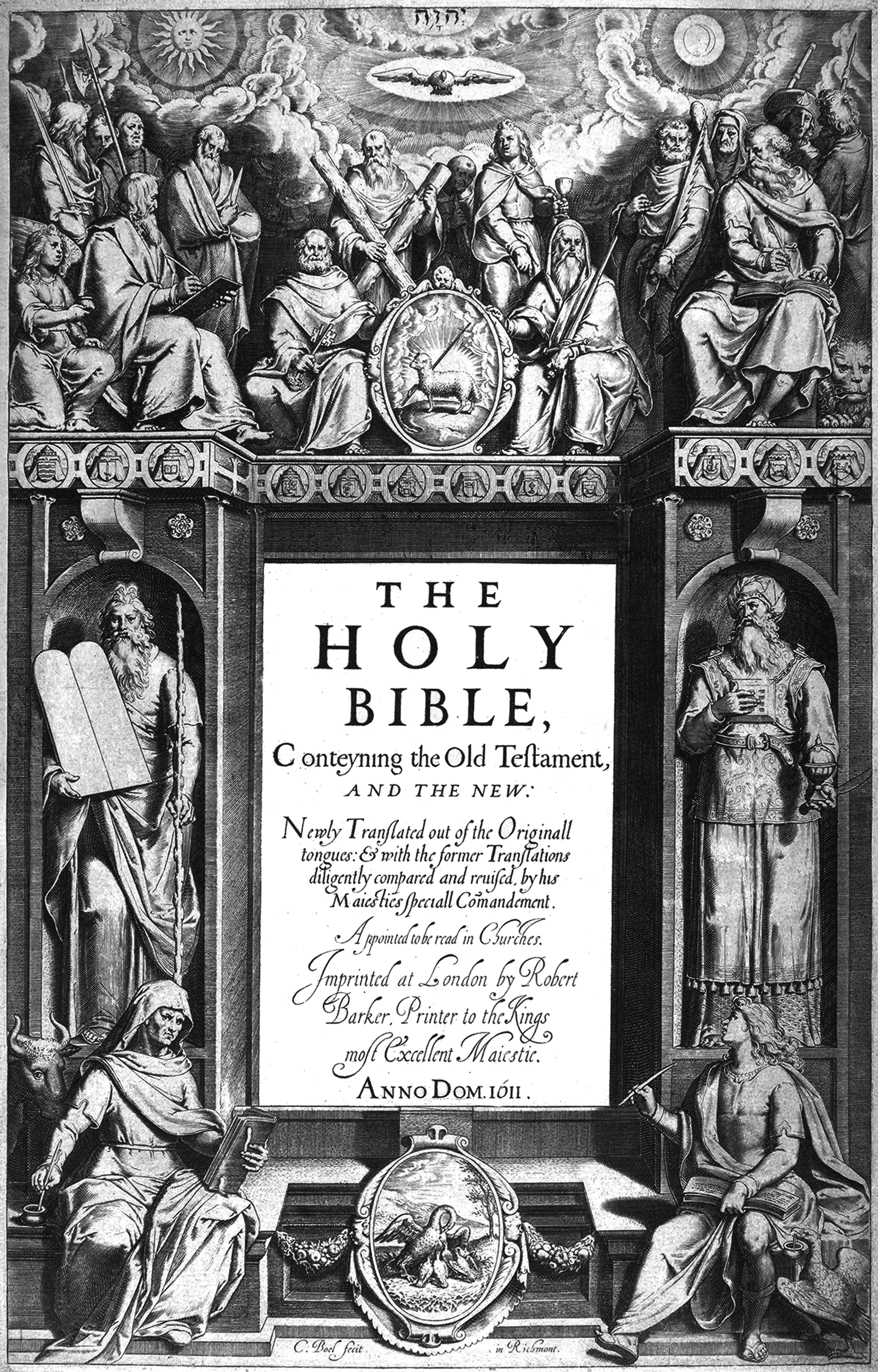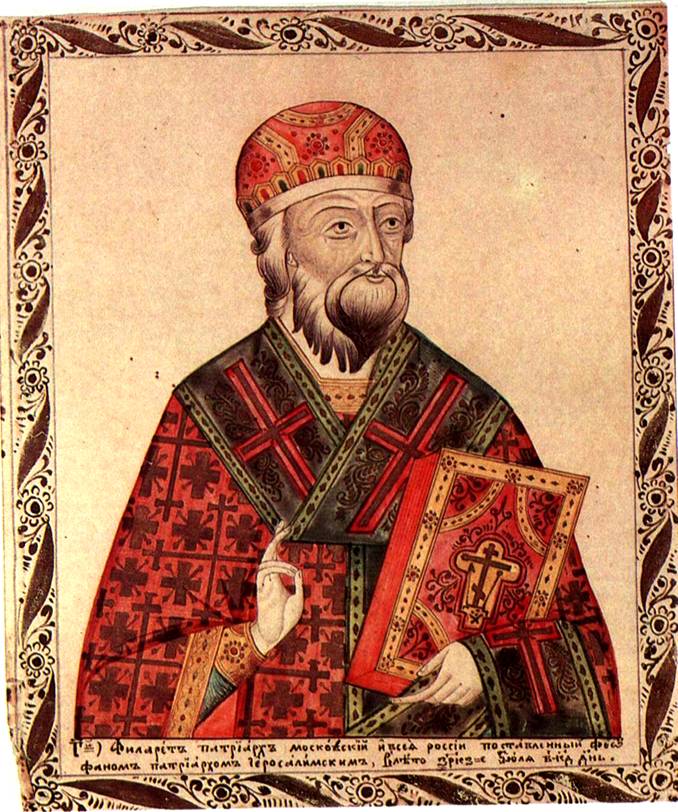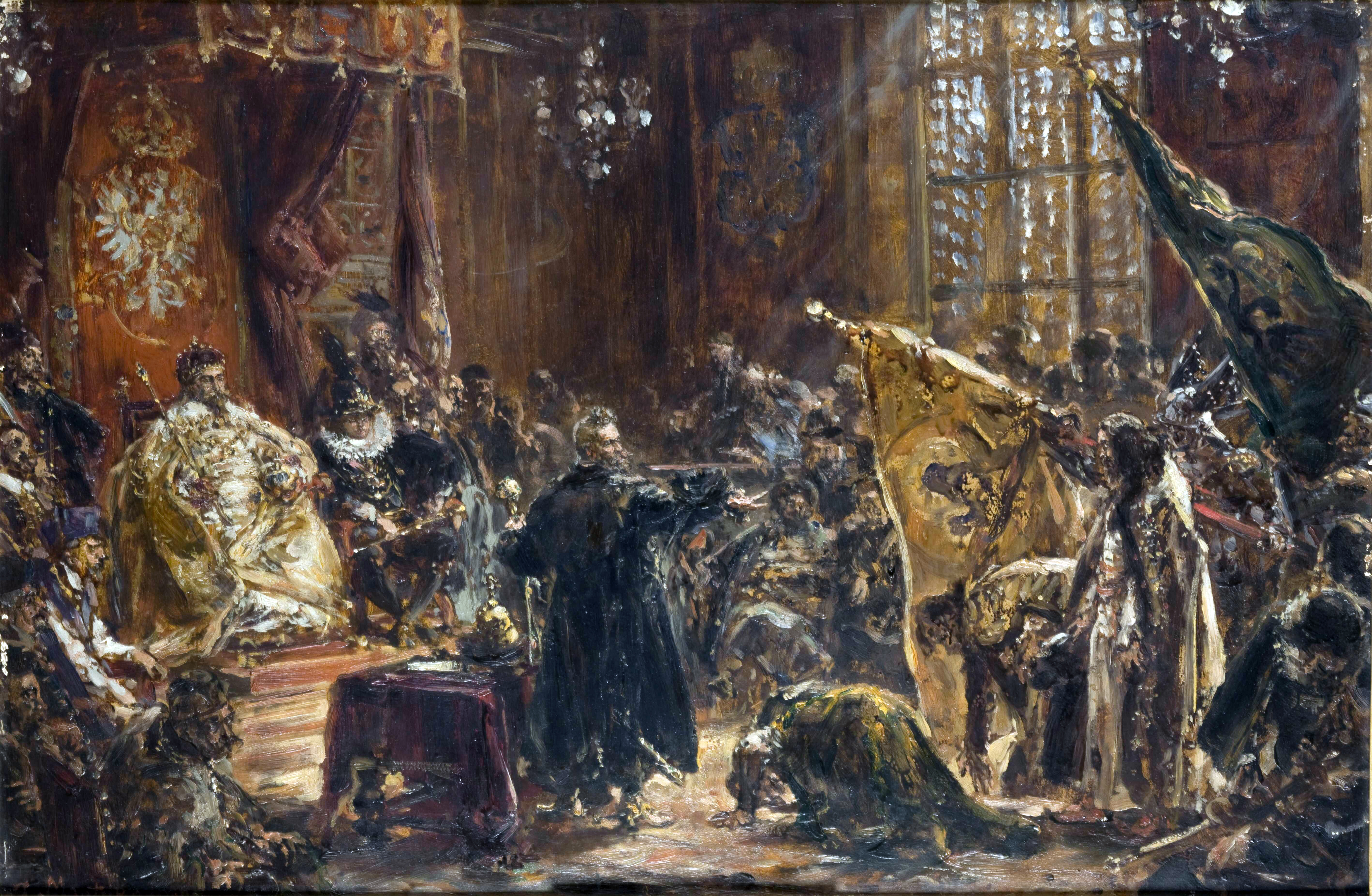|
Sejm Of 1611
The Sejm of 1611 was a meeting of the parliament of the Polish–Lithuanian Commonwealth, which took place in Warsaw between September 26 and November 9, 1611. It was called to analyze the ongoing war with Russia (see Polish–Muscovite War (1605–18)), and the recapture of the city of Smolensk (see Siege of Smolensk (1609–11)). Marshal of the Sejm was an official from Lwow, Jan Swoszowski. During the session, King Sigismund III Vasa tried to promote a bill which introduced conscription, and to persuade the envoys that the war with Russia should be continued. The Sejm ordered extra taxes, but this was not enough to finance military effort of the Commonwealth: also, the king appropriated some of the tax money, to cover the cost of Siege of Smolensk, for which he paid with his private funds. No money was sent to the Commonwealth garrison stationed in the Moscow Kremlin. On October 16, a Russian delegation came to Warsaw, asking the Sejm to immediately send Duke Wladyslaw to Mos ... [...More Info...] [...Related Items...] OR: [Wikipedia] [Google] [Baidu] |
Parliament Of The Polish–Lithuanian Commonwealth
In modern politics and history, a parliament is a legislative body of government. Generally, a modern parliament has three functions: representing the electorate, making laws, and overseeing the government via hearings and inquiries. The term is similar to the idea of a senate, synod or congress and is commonly used in countries that are current or former monarchies. Some contexts restrict the use of the word ''parliament'' to parliamentary systems, although it is also used to describe the legislature in some presidential systems (e.g., the Parliament of Ghana), even where it is not in the official name. Historically, parliaments included various kinds of deliberative, consultative, and judicial assemblies. What is considered to be the first modern parliament, was the Cortes of León, held in the Kingdom of León in 1188. According to the UNESCO, the Decreta of Leon of 1188 is the oldest documentary manifestation of the European parliamentary system. In addition, UNESC ... [...More Info...] [...Related Items...] OR: [Wikipedia] [Google] [Baidu] |
Hetman
''Hetman'' is a political title from Central and Eastern Europe, historically assigned to military commanders (comparable to a field marshal or imperial marshal in the Holy Roman Empire). First used by the Czechs in Bohemia in the 15th century, it was the title of the second-highest military commander after the king in the Crown of the Kingdom of Poland and the Grand Duchy of Lithuania from the 16th to 18th centuries. Hetman was also the title of the head of the Cossack state in Ukraine after the Khmelnytsky Uprising of 1648. Throughout much of the history of Romania and the Moldavia, hetmans were the second-highest army rank. In the modern Czech Republic, the title is used for regional governors. Etymology The term ''hetman'' was a Polish borrowing, most likely stemming via Czech from the Turkic title ''ataman'' (literally 'father of horsemen'), however it could also come from the German – captain. Since hetman as a title first appeared in Czechia in the 15th century, as ... [...More Info...] [...Related Items...] OR: [Wikipedia] [Google] [Baidu] |
1611 In The Polish–Lithuanian Commonwealth
Events January–March * January 26 – Maximilien de Béthune, Duke of Sully is forced by Queen regent Marie's Regency Council to resign as chief minister of France. He is replaced by Nicolas de Neufville, seigneur de Villeroy. * February 27 – Sunspots are observed by telescope, by Frisian astronomers Johannes Fabricius and David Fabricius. Johannes publishes the results of these observations, in ''De Maculis in Sole observatis'' in Wittenberg, later this year. Such early discoveries are overlooked, however, and the first sighting is claimed a few months later, by Galileo Galilei and Christoph Scheiner. * March 4 – George Abbot is enthroned as Archbishop of Canterbury in England. * March 9 – Battle of Segaba in Begemder: Yemana Kristos, brother of Emperor of Ethiopia Susenyos I, ends the rebellion of Melka Sedeq. * March 19– 20 – The Moscow Uprising, an armed rising of the inhabitants of Moscow in the Tsardom of Russia against the ... [...More Info...] [...Related Items...] OR: [Wikipedia] [Google] [Baidu] |
Patriarch Philaret Of Moscow
Feodor Nikitich Romanov (, ; 1553 – 1 October 1633) was a Russian boyar who after temporary disgrace rose to become patriarch of Moscow as Filaret (, ), and became de facto ruler of Russia during the reign of his son, Mikhail Feodorovich. Biography The second son of the prominent boyar Nikita Romanovich, Feodor was born in Moscow and was the first to bear the Romanov surname. During the reign of his first cousin Feodor I (1584–1598), young Feodor Romanov distinguished himself both as a soldier and a diplomat, fighting against the forces of John III of Sweden in 1590, and conducting negotiations with the ambassadors of Rudolf II, Holy Roman Emperor from 1593 to 1594. He was made a boyar in 1583. On the death of the childless tsar, he was the popular candidate for the vacant throne; but he acquiesced in the election of Boris Godunov, and shared the disgrace of his too-powerful family three years later, when Boris compelled both him and his wife, Xenia Shestova, to take mona ... [...More Info...] [...Related Items...] OR: [Wikipedia] [Google] [Baidu] |
Mikhail Shein
Mikhail Borisovich Shein (, ) (late 1570s–1634) was a leading Russian general during the reign of Tsar Mikhail Romanov. Despite his tactical skills and successful military career, he ended up losing his army in a failed attempt to besiege Smolensk and being executed for this defeat. The first Russian generalissimo, Aleksey Shein, was his great grandson. He left behind diaries, one of which is kept at the National Archives of Sweden, providing historical detail on the siege of Smolensk until his surrender in 1634. Revolts and awards In the years 1602–1603 he put down peasant revolts, and in 1606–1607, revolt of Ivan Bolotnikov. For that, in 1605 he was promoted to okolnichy, and around late 1606 / early 1607 - to a boyar. In 1607 he also became the voivode of Smolensk. First siege of Smolensk Shein's prominence dates from 1607, when he was made a boyar and sent to govern the key western stronghold of Smolensk. It was he who commanded the Russian contingent for 20 month ... [...More Info...] [...Related Items...] OR: [Wikipedia] [Google] [Baidu] |
Vasili IV Of Russia
Vasili IV Ivanovich Shuisky (, 12 September 1612) was Tsar of all Russia from 1606 to 1610, after the murder of False Dmitri I. His rule coincided with the Time of Troubles. He was the only member of Shuysky, House of Shuisky to become tsar and the last member of the Rurikid dynasty (Yurievichi branch) to rule as tsar. Life He was a son of Ivan Andreyevich Shuisky. Born Knyaz, Prince Vasili Ivanovich Shuisky, he descended from the Yurievichi sovereign princes of Nizhny Novgorod, and was allegedly a 20th-generation male-line descendant of the 9th-century Varangian prince Rurik. Vasili Ivanovich was one of the leading boyars of the Tsardom of Russia during the reigns of Feodor I of Russia , Feodor I () and Boris Godunov (). In the court intrigues of the Time of Troubles (1598–1613), Vasily and his younger brother Dmitry Shuisky usually acted together and fought as one. It was Shuisky who, in obedience to the secret orders of tsar-to-be Boris, went to Uglich to inquire i ... [...More Info...] [...Related Items...] OR: [Wikipedia] [Google] [Baidu] |
Tsar
Tsar (; also spelled ''czar'', ''tzar'', or ''csar''; ; ; sr-Cyrl-Latn, цар, car) is a title historically used by Slavic monarchs. The term is derived from the Latin word '' caesar'', which was intended to mean ''emperor'' in the European medieval sense of the term—a ruler with the same rank as a Roman emperor, holding it by the approval of another emperor or a supreme ecclesiastical official—but was usually considered by Western Europeans to be equivalent to "king". Tsar and its variants were the official titles in the First Bulgarian Empire (681–1018), Second Bulgarian Empire (1185–1396), the Kingdom of Bulgaria (1908–1946), the Serbian Empire (1346–1371), and the Tsardom of Russia (1547–1721). The first ruler to adopt the title ''tsar'' was Simeon I of Bulgaria. Simeon II, the last tsar of Bulgaria, is the last person to have held this title. Meaning in Slavic languages The title tsar is derived from the Latin title for the Roman emperors, ''c ... [...More Info...] [...Related Items...] OR: [Wikipedia] [Google] [Baidu] |
Royal Castle, Warsaw
The Royal Castle in Warsaw ( ) is a state museum and a List of Historic Monuments (Poland), national historical monument, which formerly served as the official Castle, royal residence of several List of Polish rulers, Polish monarchs. The personal offices of the king and the administrative offices of the royal court were located in the Castle from the 16th century until the final Partitions of Poland, partition of Poland in 1795. Situated in the Castle Square, Warsaw, Castle Square, at the entrance to the Old Town, Warsaw, Old Town, the Royal Castle holds a significant collection of Polish and European art. The Royal Castle witnessed many notable events in Poland's history; the Constitution of 3 May 1791, first of its type in Europe and the world's second-oldest codified national constitution, was drafted here by the Great Sejm, Four-Year Parliament. The edifice was redesigned into a Neoclassical architecture, neoclassical style following the partitions of Poland. Under the Secon ... [...More Info...] [...Related Items...] OR: [Wikipedia] [Google] [Baidu] |
Stanislaw Zolkiewski
Stanislav and variants may refer to: People *Stanislav (given name), a Slavic given name with many spelling variations (Stanislaus, Stanislas, Stanisław, etc.) Places * Stanislav, Kherson Oblast, a coastal village in Ukraine * Stanislaus County, California * Stanislaus River, California * Stanislaus National Forest, California * Place Stanislas, a square in Nancy, France, World Heritage Site of UNESCO * Saint-Stanislas, Mauricie, Quebec, a Canadian municipality * Stanizlav, a fictional train depot in the game '' TimeSplitters: Future Perfect'' * Stanislau, German name of Ivano-Frankivsk, Ukraine Schools * St. Stanislaus High School, an institution in Bandra, Mumbai, India * St. Stanislaus High School (Detroit) * Collège Stanislas de Paris, an institution in Paris, France * California State University, Stanislaus, a public university in Turlock, CA * St Stanislaus College (Bathurst), a secondary school in Bathurst, Australia * St. Stanislaus College (Guyana), a secondary school ... [...More Info...] [...Related Items...] OR: [Wikipedia] [Google] [Baidu] |
Warsaw
Warsaw, officially the Capital City of Warsaw, is the capital and List of cities and towns in Poland, largest city of Poland. The metropolis stands on the Vistula, River Vistula in east-central Poland. Its population is officially estimated at 1.86 million residents within a Warsaw metropolitan area, greater metropolitan area of 3.27 million residents, which makes Warsaw the List of cities in the European Union by population within city limits, 6th most-populous city in the European Union. The city area measures and comprises List of districts and neighbourhoods of Warsaw, 18 districts, while the metropolitan area covers . Warsaw is classified as an Globalization and World Cities Research Network#Alpha 2, alpha global city, a major political, economic and cultural hub, and the country's seat of government. It is also the capital of the Masovian Voivodeship. Warsaw traces its origins to a small fishing town in Masovia. The city rose to prominence in the late 16th cent ... [...More Info...] [...Related Items...] OR: [Wikipedia] [Google] [Baidu] |






